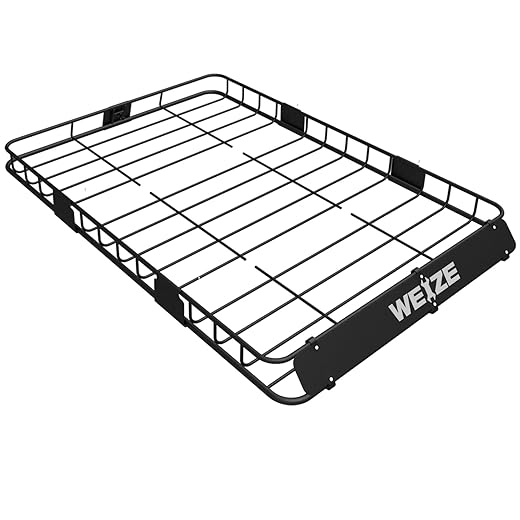As an avid outdoor enthusiast, I understand the excitement of planning an adventure, whether it’s a weekend camping trip or a cross-country road journey. One of the essential components for these excursions is a reliable roof rack, especially one that’s easy to install. However, navigating the myriad of options can be overwhelming. In this blog post, I will help you explore key factors to consider before making your purchase, ensuring you select the right roof rack that not only meets your vehicle’s specifications but also enhances your travel experience. Let’s simplify the decision-making process together, so you can focus on what truly matters: your next adventure.



Compatibility with Your Vehicle
Ensuring that your roof rack is compatible with your vehicle is critical for both safety and performance. A mismatch between the roof rack and the specific make and model of your vehicle can lead to numerous issues, from decreased functionality to potential damage to your car.
Why Compatibility Matters
When it comes to roof racks, compatibility means that the rack should fit securely onto your vehicle without compromising its structure or safety. An incompatible roof rack can result in:
- Damage to the Vehicle: A poorly fitting roof rack can scratch, dent, or otherwise damage the vehicle’s roof.
- Safety Hazards: An unstable or improperly secured load increases the risk of accidents, especially at high speeds or during sharp turns.
- Functionality Issues: The roof rack may not perform its intended function if it’s not suited for your vehicle’s specifications.
Mounting Systems to Consider
Different vehicle models require different mounting systems. It’s essential to choose a roof rack that matches your vehicle’s roof type. Here are some common types of mounting systems:
- Bare Roof: These vehicles don’t have factory-installed mounting points. Roof racks like the Thule AeroBlade or Yakima JetStream are designed for bare roofs, using adjustable clamps to fit securely.
- Raised Rails: For SUVs and crossovers with raised side rails, racks such as the Inno vs. Yakima Crossbars can be attached quickly and easily.
- Fixed Points: Some vehicles have factory-installed anchoring points. Roof racks like the Rhino Rack Vortex are suitable for those with pre-existing mounting points, ensuring a secure fit.
- Gutters: Classic vehicles or certain trucks with gutter mounts can use racks designed for this system, such as the Thule Classic Gutter Foot.
Understanding Weight Limits
Every roof rack comes with a maximum weight limit. Exceeding this limit can compromise both the integrity of the rack and your vehicle’s roof. Here are a few examples of weight limits for popular roof rack models:
| Product | Weight Limit | Type |
|---|---|---|
| Thule AeroBlade | 165 lbs | Aerodynamic |
| Yakima JetStream | 165 lbs | Aerodynamic |
| Rhino Rack Vortex | 220 lbs | Heavy-duty |
| Inno Crossbars | 154 lbs | Lightweight |
Key Considerations for Weight:
- Always check the vehicle’s owner’s manual for the maximum roof load capacity.
- Account for the weight of the roof rack itself in your calculations.
- Ensure that combined weight (rack + gear) does not exceed recommended limits.
Vehicle Specifications to Look For
Before purchasing a roof rack, check the following specifications:
- Roof Width and Length: Make sure your selected roof rack accommodates your vehicle’s specific dimensions. A versatile option is the Thule WingBar Edge, which offers adjustable widths.
- Aerodynamics: Look for racks designed with aerodynamics in mind to reduce wind noise and improve fuel efficiency, such as the Yakima JetStream.
- Vehicle Warranty Considerations: Ensure that using a roof rack won’t void any warranties associated with your vehicle.
How Checking for Compatibility Prevents Issues
By taking the time to verify compatibility, you can prevent the following potential problems:
- Damage from poorly fitting racks: Repeated movements or wind pressure can cause the rack to shift, leading to costly damage.
- Increased wear on vehicle roof: Incompatible racks can lead to scratches or paint removal over time.
- Potential accidents: An unstable load—caused by an unsuitable roof rack—can lead to accidents, endangering both the driver and others on the road.
Real-World Examples
Consider a Subaru Outback owner looking for a roof rack. For this vehicle, a perfect fit would be the Yakima CrossBar Platform, which is compatible with its factory-installed side rails and supports an impressive weight limit while enhancing the vehicle’s overall functionality. On the other hand, a Nissan Rogue owner might opt for the Thule SquareBar as it is specially designed to fit vehicles with raised rails.
By ensuring your roof rack is the right match for your car, you not only protect your investment but also enhance your outdoor experiences, whether you are carrying bikes, kayaks, or luggage. Following these guidelines will lead to a safe and efficient roof rack setup tailored to your specific vehicle needs.
Type of Roof Rack
When it comes to adding storage flexibility to your vehicle, roof racks provide an excellent solution for outdoor enthusiasts and everyday users alike. With various options on the market, it’s vital to understand the features and benefits of each type of roof rack. Below, we’ll explore easy-install roof racks, including crossbars, cargo boxes, and bike racks, and help you determine which one aligns best with your lifestyle.
1. Crossbars
Overview
Crossbars are the foundational component of most roof rack systems. They sit across the roof of your vehicle, allowing you to attach additional accessories like cargo carriers and bike racks.
Features and Benefits
- Versatility: Crossbars can serve as a base for multiple types of cargo accessories.
- Adjustability: Many models are adjustable to fit various vehicle widths.
- Weight Capacity: High-quality crossbars can support a significant load, often ranging from 100 to 200 pounds.
Popular Options
- Thule AeroBlade Edge: Known for its aerodynamic design, this model minimizes wind noise while providing robust support.
- Yakima JetStream: This crossbar system features a lightweight yet durable aluminum construction, ideal for various accessories.
Installation
Most crossbars can be mounted in under an hour. Adjustable brackets typically align with factory mounting points or clamps that securely fasten without drilling.
2. Cargo Boxes
Overview
Cargo boxes offer enclosed storage solutions that protect your items from the elements. They attach directly to crossbars and are perfect for transporting gear, luggage, or recreational equipment safely.
Features and Benefits
- Weather Resistance: Most cargo boxes are designed to be waterproof and resistant to UV rays.
- Security: Built-in locks offer peace of mind when storing valuables.
- Aerodynamic Design: Reduces drag and noise during travel.
Popular Options
- Thule SkyBox Carbonite 16: This spacious and stylish cargo box provides 16 cubic feet of storage and is compatible with most crossbar systems.
- Yakima SkyBox 12: Slightly smaller but equally functional, this model is perfect for families or individuals making quick trips.
Installation
Cargo boxes are designed for quick mounting, often requiring just a few tools. Most brands provide clamp systems that make attachment and removal straightforward.
3. Bike Racks
Overview
Bike racks are essential for cyclists who want to transport their bicycles securely without damaging them or their vehicle. They come in various styles, including hitch-mounted, trunk-mounted, and roof-mounted.
Features and Benefits
- Dedicated Space: Frees up interior space while providing safe transport for bicycles.
- Support for Multiple Bikes: Many bike racks can accommodate 2-4 bikes, making them ideal for family adventures.
- Ease of Loading: Designs such as tilt-down features allow access to the trunk without removing the bikes.
Popular Options
- Thule T2 Pro XT: A hitch-mounted rack that can hold up to two bikes. Its removable frame clamp system ensures that your bikes are held securely without touching the frame.
- Yakima HighRoad: This roof-mounted bike rack fits most bike designs and eliminates contact with your bike’s frame.
Installation
Bike racks are typically easy to install, with most Hitches requiring minimal tools. Roof-mounted models often use a clamping mechanism, while trunk racks may rely on straps and hooks.
Summary of Roof Rack Types
| Roof Rack Type | Key Features | Ideal Use | Example Products |
|---|---|---|---|
| Crossbars | Versatile, adjustable, durable | Base for other accessories | Thule AeroBlade Edge, Yakima JetStream |
| Cargo Boxes | Weather-resistant, secure, aerodynamic | Long trips with luggage/gear | Thule SkyBox, Yakima SkyBox 12 |
| Bike Racks | Dedicated space, ease of loading | Biking trips or family outings | Thule T2 Pro XT, Yakima HighRoad |
By evaluating your outdoor activities and cargo storage needs, you can make an informed decision on the type of roof rack that best suits your lifestyle. Whether you require a sturdy set of crossbars for mounting accessories, a weatherproof cargo box for seasonal trips, or a reliable bike rack for cycling adventures, there is a perfect solution waiting for you.
Final Thoughts: Key Takeaways for Your Roof Rack Decision
In conclusion, purchasing an easy-install roof rack requires careful consideration of several key factors. It’s essential to ensure compatibility with your vehicle, choose the right type of roof rack that meets your needs, assess the ease of installation, and establish a budget that aligns with your financial situation. I encourage you to weigh these factors thoughtfully and suggest creating a checklist to simplify your decision-making process. By doing so, you’ll be better equipped to select a roof rack that enhances your travel experience and meets your requirements effectively.
I’d love to see a section on how to maintain roof racks after installation. Any tips on that?
That’s a fantastic idea! Keeping your roof rack clean and checking the hardware regularly can really extend its life. I’ll consider writing a piece on maintenance in the future!
I’ve had a Thule AeroBlade Edge rack for a couple of years now, and it’s been awesome! Super easy to install and take off. What are your thoughts on Thule vs. Yakima?
Thanks for sharing your experience! Both Thule and Yakima make great products, but they do have different designs and features that might cater to different needs. It often comes down to personal preference!
Any chance you could dive into the differences between fixed and removable racks in a future post? I’m still a bit lost on which is better!
Great suggestion! The choice between fixed and removable can really depend on your usage. I’ll definitely consider covering that in a future article!
Love the article! Do you have any resources for DIY installation videos? Sometimes it’s easier to follow along with a video.
Absolutely! YouTube has a ton of helpful DIY videos for roof rack installations. Just search for your specific model, and you should find plenty of guides!
I’ve always been hesitant about roof racks because they seem like they could damage the car’s roof. How can I avoid that?
It’s a valid concern! Using rubber padding or feet on the racks can help prevent damage, and always make sure they’re properly fitted. Just take your time during installation!
I noticed you didn’t mention anything about weight limits on roof racks. Can you touch on that a bit? It seems super important!
Great point! Weight limits can vary quite a bit between different racks, and it’s crucial to check both the rack’s rating and your vehicle’s roof capacity. Always better to be safe than sorry!
Could you recommend some easy-install roof racks for sedans? I’m looking for something that won’t break the bank.
Definitely! For sedans, the Rhino Rack Vortex and the Yakima JetStream are solid options that are easy on the wallet and user-friendly!
Hey, can you explain more about how to check if a roof rack is compatible with my specific vehicle model? That’s always a bit confusing!